<< Previous | Displaying results 1601-1625 of 6707 for "" | Next >>
-
Small hooked rug used in the wagon of a Romani (Gypsy) family
ArtifactThis small patterned hooked rug was used as a shoe mat in the wagon of Rita Prigmore and her family when she was a child in Wurzberg, Germany, after World War II. Rita and her family were members of the Sinti group of Roma (Gypsies). She and her twin sister Rolanda were born in 1943. Rolanda died as a result of medical experiments on twins in the clinic where they were born. Rita was returned to her family in 1944. She and her mother survived the war and moved to the United States, before returning to…
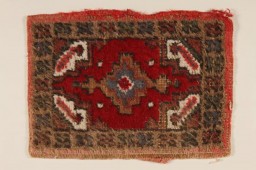
-
Blacksmith's bellows used in a Romani (Gypsy) encampment
ArtifactThese blacksmith's bellows were used by Romani (Gypsy) artisan Juri Cervenuak in Trebisov, Slovakia, in 1939. Many Roma traditionally worked as craftsmen and were blacksmiths, cobblers, tinsmiths, horse dealers, and toolmakers.
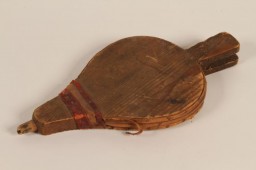
-
1936 Berlin Olympics torch holder
ArtifactThis Olympic torch holder was used during the 1936 Berlin Olympics. It is engraved with the 1936 Olympics torch relay route from Olympia, Greece, to Berlin, Germany.
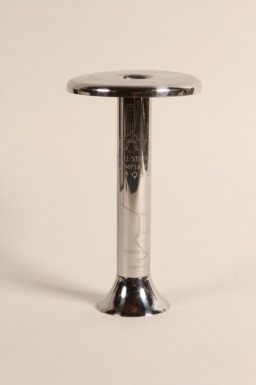
-
1963 postage stamp commemorating Treblinka
ArtifactIn 1963, the German Democratic Republic (DDR) issued this postage stamp to commemorate the Treblinka killing center. This was the first stamp of a series issued annually by the DDR under the name Mahn- und Gedensksatte (Remembrance and Memorial Center) in remembrance and commemoration.
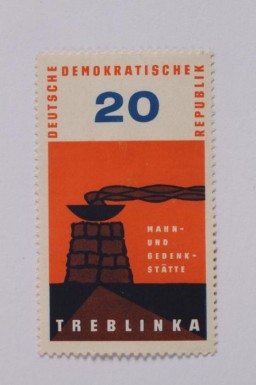
-
Krakow ghetto armband
ArtifactIn December 1939, German authorities required Jews residing in the Generalgouvernement (which included Krakow) to wear white armbands with blue Stars of David for purposes of identification. The armband pictured here was donated to the United States Holocaust Memorial Museum in 2001 by Akiva Kohane.
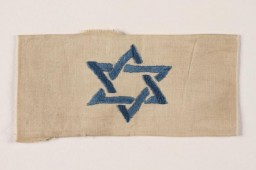
-
Nazi banner
ArtifactNazi banner with a swastika. The swastika became the most recognizable symbol of Nazi propaganda, appearing on the Nazi flag, election posters, arm bands, medallions, and badges for military and other organizations.

-
Drawing of shoes by a Jewish teenager in hiding
ArtifactJewish teenager Ava Hegedish drew this poignant picture of her mother's well-worn shoes while in hiding. It was drawn while Ava was in hiding at a farm near Belgrade, Yugoslavia (now Serbia), between 1941 and 1944. Once Nazi Germany and its Axis partners partitioned Yugoslavia and Belgrade fell under German control, Ava’s father thought the family’s best chance of survival was to separate and go into hiding. Ava ended up at a farm with some extended-family Serbian relatives. Because she…
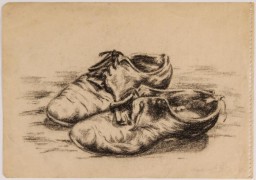
-
Alice (Lisl) Winternitz's luggage tag
ArtifactThis paper tag identified bedding belonging to Alice (Lisl) Winternitz when she was deported from Prague, Czechoslovakia, to the Theresienstadt ghetto in June 1942.
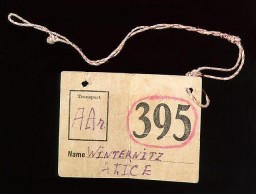
-
White armband with blue Star of David
ArtifactWhite armband with a Star of David embroidered in blue thread, worn by Dina Offman from 1939 until 1941 while in the ghetto in Stopnica, Poland.
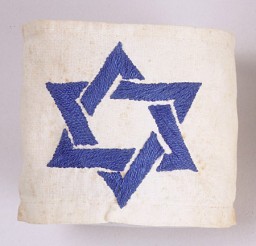
-
White armband with blue Star of David
ArtifactWhite armband with a Star of David embroidered in blue thread, worn by Dina Offman from 1939 until 1941 while in the ghetto in Stopnica, Poland.
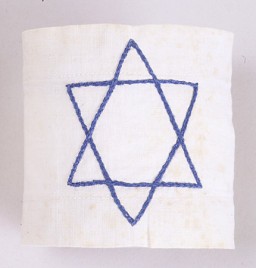
-
Doll from the Krakow ghetto
ArtifactZofia Burowska (Chorowicz) donated this doll, which dates from the 1930s, to the United States Holocaust Memorial Museum. Zofia's parents gave her the doll before the war and she kept it with her in the Wolbrum and Krakow ghettos, Poland. The doll and some of her family's other belongings were left with non-Jewish friends for safekeeping. Zofia was deported to a forced-labor camp for Jews near Krakow, to the Skarzysko-Kamienna camp (also in Poland), and then to the Buchenwald concentration camp in Germany,…
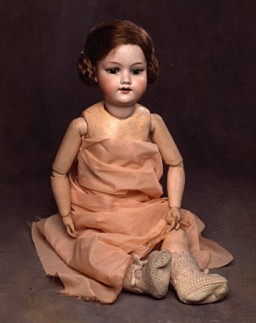
-
Lodz ghetto model
ArtifactLeon Jakubowicz, a shoemaker by training and a native of Lodz, began constructing this model of the Lodz ghetto soon after his arrival there from a prisoner-of-war camp in April 1940. The case holds a scale (1:5000) model of the ghetto, including streets, painted houses, bridges, churches, synagogue ruins, factories, cemeteries, and barbed wire around the ghetto edges. The model pieces are made from scrap wood. The case cover interior is lined with a collection of official seals, a ration card, and paper…
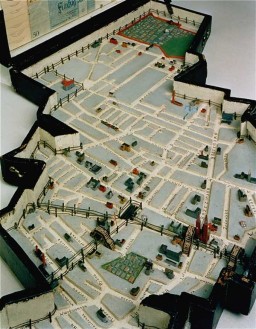
-
Stroop Report cover
ArtifactSS Major General Juergen Stroop, commander of German forces that suppressed the Warsaw ghetto uprising, compiled an album of photographs and other materials. This album, later known as "The Stroop Report," was introduced as evidence at the International Military Tribunal at Nuremberg. Here, its cover is marked with an IMT evidence stamp.
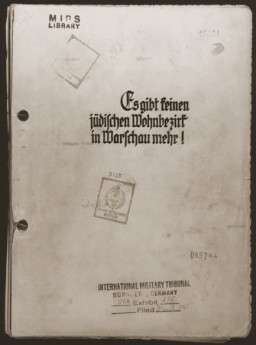
-
Backpack belonging to Ruth Berkowitz
ArtifactThis tan backpack was used by Ruth Berkowitz to carry her belongings as she fled from Warsaw via Lithuania and the Soviet Union to Japan. Most of her possessions were confiscated by both the Nazis and the Soviets during her journey. [From the USHMM special exhibition Flight and Rescue.]

-
Model of the Lodz ghetto
ArtifactLeon Jakubowicz, a shoemaker by training and a native of Lodz, began constructing this model of the Lodz ghetto soon after his arrival there from a prisoner-of-war camp in April 1940. The case holds a scale (1:5000) model of the ghetto, including streets, painted houses, bridges, churches, synagogue ruins, factories, cemeteries, and barbed wire around the ghetto edges. The model pieces are made from scrap wood. The case cover interior is lined with a collection of official seals, a ration card, and paper…
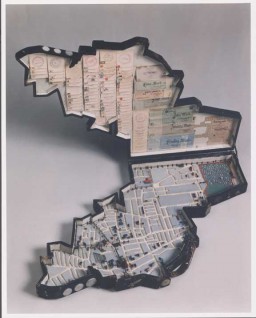
-
Boots issued to Jacob Polak by the Red Cross
ArtifactSurvivors of the camps lacked even basic possessions, such as footwear. The Red Cross issued these United States Army boots to Jacob Polak in June or July 1945 after his repatriation to the Netherlands.

-
Candlesticks taken to Vilna by Polish Jewish refugees
ArtifactA pair of candlesticks, bought in Poland and used every Friday evening during observance of the Jewish Sabbath. Polish Jewish refugees fleeing the German invasion of Poland in 1939 carried these candlesticks with them to Vilna.

-
Refugee's suitcase
ArtifactA suitcase used (ca. 1939) by a Jewish refugee fleeing Nazi-occupied Europe to Japan. The suitcase is covered with labels from various stops along the journey, including one from a hotel in Moscow (top left), one for the NYK Line (top middle), and six from hotels throughout Japan. [From the USHMM special exhibition Flight and Rescue.]
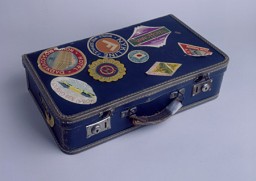
-
Child's Sweater Worn in Hiding
ArtifactDuring the 1943 liquidation of the Lvov ghetto, dozens of Jews fled into the city sewers to escape death. Eight-year-old Krystyna Chiger (later Kristine Keren) hid with her family and 16 others beneath the city's streets for 14 months, during which she wore this sweater.

-
Dress Worn by a Hidden Child
ArtifactA blue and white child's dress worn by Sabina Kagan while living in hiding with the Roztropowicz family in Radziwillow, Poland, during World War II. Her rescuers used doll's clothing to make this dress. Sabina was just an infant when SS mobile killing squads began rounding up Jews in the Polish village of Radziwillow in 1942. Her parents persuaded a local policeman to hide the family. The policeman, however, soon asked the Kagans to leave but agreed to hide baby Sabina. Her parents were captured and…

-
Dress Worn by a Child in Hiding
ArtifactA child's dress embroidered with red and blue flowers with small green leaves. This dress was hand embroidered by Lola Kaufman's mother in the Czortkow ghetto. Lola (born Lea Rein) wore this dress when she went into hiding. Lola was hidden first under a bed in the house of the woman who used to deliver milk to the family, then in a dugout under a cellar of a barn where she joined three other Jews in hiding. In March 1944, the Soviets liberated the area. The hidden Jews left their hideout in the middle of…
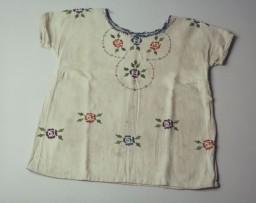
-
Karel Bruml's concentration camp cap
ArtifactAfter being deported from Theresienstadt to the Auschwitz concentration camp in 1942, Karel Bruml wore this cap as a forced laborer in the Buna synthetic rubber works located in the Buna-Monowitz section of the camp.
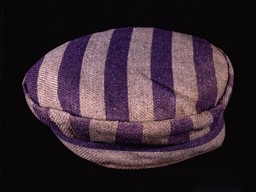
-
Abraham Lewent's prisoner jacket
ArtifactAbraham Lewent, who had been sent from the Warsaw ghetto to Majdanek and later transferred to several concentration camps in Germany, wore this jacket as part of the uniform issued to him upon his arrival in the Buchenwald concentration camp in 1944.
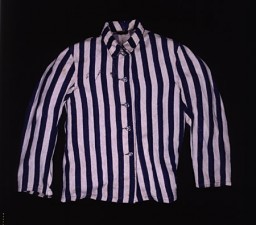
-
Julian Noga's prisoner uniform jacket
ArtifactA blue and gray striped jacket from the Flossenbürg concentration camp. The letter "P" on the left front of the jacket indicates that it was worn by a Polish, non-Jewish prisoner. "P" stands for "Pole" in German. The jacket was donated to the United States Holocaust Memorial Museum by the prisoner who wore it, Julian Noga.
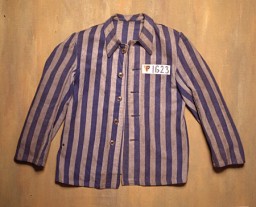
-
Hana Mueller's concentration camp skirt
ArtifactHana Mueller altered this skirt issued to her in the Auschwitz concentration camp in 1944 by using the hem to make pockets.

